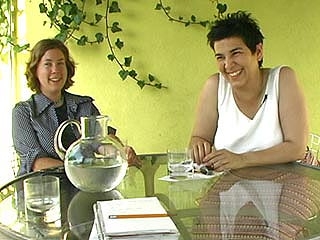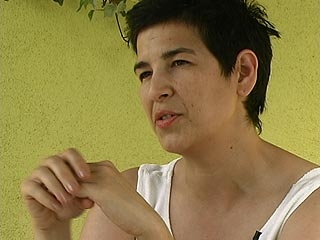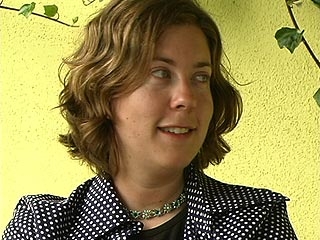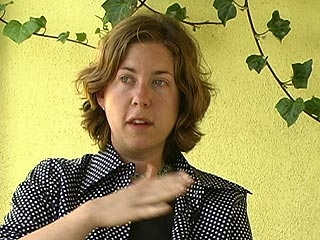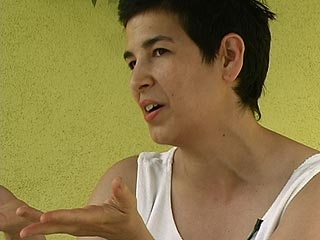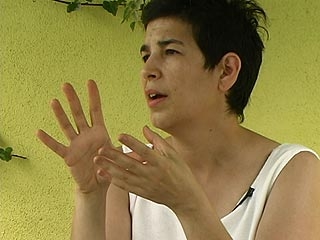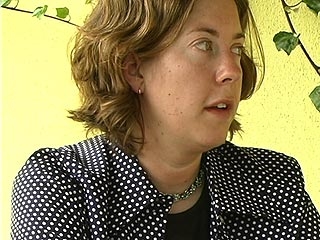Feature: Conversations
Courtney Fink and Irene Tsatsos
Sometime between your 28th and 30th years, an astrologer will tell you, marks the end of youth and the beginning of making your adult contribution to the world. Two of California’s preeminent alternative spaces are at or near that turning point. When young artists in need of an alternative to commercial galleries started San Francisco’s Southern Exposure (SoEx) and Los Angeles Contemporary Exhibitions (LACE) in the 1970s, 2004 was science fiction. But this year SoEx marks its 30th anniversary and LACE its 26th. Having survived the delicate start-up years, the inevitable departure of founders, and the virtual end of government funding for the arts, these two alternative spaces find themselves senior players in the ever-youthful “emerging art” scene.
In the summer of 2003, Stretcher brought together Courtney Fink, the director of Southern Exposure, and Irene Tsatsos, the director of LACE, to discuss the future of their respective organizations and the changing climate for alternative spaces in general. As the strategists leading two of California’s most historically important spaces discussed keeping their organizations fertile and solvent, Stretcher admired their dedication and endurance.
Meredith Tromble
Stretcher What did you know about LACE before you came here? You came from a very different scene…
Irene Tsatsos I knew of LACE from when I was in art school. I was working at Randolph Street Gallery in Chicago and had heard of it through that connection. Also, Lynn Hickson and Matthew Goulish moved to Chicago and they had been involved with LACE. When I was at the Whitney I was approached about this job; since I had worked at the Whitney with a number of artists based in L.A. I had a good range of people to ask for more information and help me figure out, am I insane for coming out here and taking this job or what? I knew the history. I knew that LACE had an amazing role in L.A., having been the principal place for presenting the most important contemporary art. If you were interested in seeing contemporary art, you had to go to LACE. When it was founded, there was a handful of blue chip galleries dealing with contemporary art, but that was it. MOCA didn’t exist. LACMA was showing a little contemporary work, but not much. And I also knew that despite this history, in recent years LACE had been having a lot of difficulties.
Stretcher If you were to summarize the difficulties that it had run into, how would you characterize them?
IT By the mid-1990s, LACE was not responding effectively to the changed climate in the art world here—a changed climate that LACE was instrumental in creating. LACE was effective in generating interest in contemporary work, but it didn’t stay ahead of the curve. There was an uncritical commitment to founding principles and founding ways of governance rather than a critical or an examined commitment. I think that core values, values that are there at the inception of an organization, can remain core values for decades, but how those values are developed or what kind of structure exists around them is something that can change. And I think LACE hadn’t examined that carefully enough. And, also I think that a lot of organizations around the country that were founded around the same time just did not see the writing on the wall in terms of public funding and the NEA and had become very, very dependent. So LACE and others were cut off abruptly and left without much in the way of other means of support.
Courtney Fink I’m from L.A., I grew up here. When I was interested in the arts as a young person, LACE was really the only place to go. I didn’t find out about it until I was older, until I had my own wheels and ran around the city—there wasn’t anything else like it. Now it seems like there is so much going on here. But LACE seems to me to be the only non-profit that supports this kind of energy. There are other nonprofits, but they’re attached to schools or have other purposes. They’re not just galleries.
IT I’m curious about what you’ve noticed at Southern Exposure about the effects of gaining a distance from the founding ideals and strategies.
CF It’s not so much distance from ideals. It’s distance from how those ideals were addressed. That’s a big difference.
IT How would you describe those ideals? What was the key mission?
CF At SoEx, we have a very collective model, and as a result, we’re forced to work with many people and address the community’s needs. We have to stay on top of the ideal. I’m always wondering why what we do is different from what other galleries do. How can we provide something that the other spaces don’t? Why do people want to come to SoEx? What is we’re trying to do? It’s definitely an issue. And survival—constantly having to fight your way from one phase to the next while staying ahead of the curve can be really challenging. It’s easy to get caught up in raising money. In all of my years of doing this, I haven’t gone one year without at least going to one conference where there’s a huge conversation about “why do we still exist”, or “how are we going to survive the next five years?” or “how is this economic downturn going to affect us?” “What can we do to actually come out of it and survive?”
Stretcher Was the LACE model also collective in the sense that many people had to make decisions? For LACE, was the process of reevaluation was different? Was there was more agreement along the way and then, bam! a wake up call?
IT That’s not inaccurate. LACE was founded collectively by artists who were meeting a need. There were very few opportunities for showing certain types of contemporary art, especially work with a focus on media and performance. It was about showing work that wasn’t seen otherwise, and that is something that remains a core value, to use the term that we’ve been using internally. What isn’t being seen otherwise? Where can we have a cultivating role? These are questions that we keep coming back to. It was those questions that caused the founders to create LACE.
There very much is a continuum that we’ve been operating on, but there was a moment when how that happened changed a lot. LACE was founded by a group of artists and fairly shortly after that, an executive director was hired, and that position was about managing various committees. All the programming was done by committee. Fairly quickly, by the mid-1980s, there was a video committee, a performance committee, an education committee and exhibition committee and there may have been an education committee, too. And then there were committees related to development or other sorts of administrative matters. So there was a lot to manage on the staff’s part in terms of that whole group of volunteers. That model ran well for a long time, but it also ran its course. When I was considering coming out here and talking to artists that had been involved with LACE there was a lot of feeling that the curatorial committee thing had run its course.
Specifically, artists were frustrated at having been recruited to curate for program committees, but finding themselves instead being the preparators, the cheap no-cost art handlers. Funding was diminishing rapidly, so the artists committees’ roles were changing from being creative programming people to being cheap labor. No one wanted to do that. It just wasn’t a viable model. There was a lot of resentment. When I was considering this job and talking with the board, I was very candid about not wanting to manage an artist-run organization, having done that in the past. And the board accepted that proposal and voted to disband the committees and I was hired as the director-curator. The programming is now done by staff rather than committees. The board remains a working board with a focus on long-term planning rather than on day-to-day administrative activities like stuffing envelopes. It’s a switch, a very real and powerful switch, on how the board functions.
CF It’s interesting to hear you talk about the evolution of curating at LACE. A lot of art spaces have gone that way, and running an organization that hasn’t gone that way, I understand everything that you’re saying. It is labor intensive to manage the people and to make sure they understand the organization’s concerns so that when they’re making a decision, they have an idea of how it impacts the budget and the staff.
IT And the mission of the organization.
CF I used to work with an organization that was staff-curated and I think it’s smart to go the way LACE has gone, because I think sometimes an organization is languishing and needs a change. If you want to make programming stronger, you need a devoted group of people working full-time. It doesn’t necessarily diminish an organization’s mission and can make perfect sense. SoEx’s founding principle is a community-based, collective model. Everyone in the organization likes the community model, though it has its ups and downs. There’s a three year term for curators, and, depending on who is on the committee, it could function completely differently. Right now, there is a really devoted group of people.
When I arrived the programs had been set for quite a while and so curators couldn’t change anything. They would show up for meetings, and it was like, the schedule is full, we can’t choose anything else, so what can we do with our time to help? Some people do get resentful if you ask them to help out on the floor or get them to install work. It’s not why they are there, necessarily. But, the way SoEx works, when someone comes onto the committee, it’s not just as a curator, it’s as a volunteer as well. We ask them to help out, because curating takes up so little of their time. LACE’s model seems more like an East coast, director-curator model. Art spaces in New York seem to be run by staff, it’s staff driven energy. In San Francisco, there really isn’t that model, it’s more committee or board driven.

